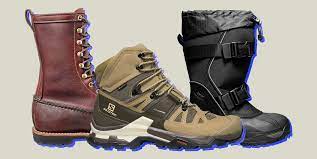If you’re someone who values both fashion and functionality, you have likely considered investing in a pair of Hunter boots. With their iconic design and waterproof construction, they’re a popular choice for rainy days and muddy festivals. But what about wearing Hunter boots in the snow?
Can they handle the harsh winter conditions and keep your feet warm and dry?
In this guide, we will explore the pros and cons of wearing Hunter boots in the snow and provide some tips for maximizing their performance in chilly weather. Whether you’re a fashion-forward trendsetter or a practical outdoor enthusiast, you’ll want to read on to discover if Hunter boots are a viable option for your winter wardrobe.
Are Hunter Boots Suitable for Snow?
Hunter boots are not designed to provide adequate insulation in snowy conditions. The rubber material used to construct these boots provides no warmth or protection from the cold. Moreover, the soles of Hunter boots are flat and smooth, which makes them extremely slippery on icy and snowy surfaces. This lack of traction and grip can lead to dangerous falls and injuries.
1. They Are Not Insulated
Hunter boots are a popular choice among fashion-conscious individuals, but they may not be the best option for snowy conditions. This is because they are not insulated, which means they do not offer much protection against the cold. While these boots are great for keeping your feet dry during rainy weather, they may not be suitable for use in snow.
To stay warm in snowy conditions, it is important to choose boots that are well-insulated. While it is possible to make insulated hunter boots yourself, it may be more practical to invest in a pair of boots specifically designed for cold weather.
With the right boots, you can enjoy the winter season without having to worry about cold feet or frostbite. So if you’re planning to venture out in the snow, make sure to choose the right footwear to keep your feet warm and comfortable.
2. No Traction For Snow
When it comes to winter weather, it is important to have the right gear to keep you safe and comfortable. While Hunter boots are a popular choice for rainy weather and muddy conditions, they are not suitable for snowy conditions. This is because they lack the necessary traction needed for walking on snow and ice.
3. They May Crack In The Snow
Hunter boots are known for their durability and waterproofing, making them a popular choice for rainy seasons and mild winters. However, wearing Hunter boots in the snow may not be the best idea. The primary reason is that they are made of rubber, which cannot withstand extremely low temperatures. In such conditions, the rubber material may harden, lose its elasticity, and eventually crack. This can not only damage your boots but also leave your feet wet and cold.
Therefore, it is recommended to avoid wearing Hunter boots in snowy conditions and opt for more suitable alternatives such as snow boots.
Snow boots are designed to keep your feet warm and dry, with features like insulation and waterproofing that can withstand harsh winter weather conditions. By choosing the right footwear for the conditions, you can enjoy your winter activities comfortably without worrying about damaging your boots.

How to Turn Your Hunter Boots into Snow Boots?
1. Wear Thick Hunter Socks
One way to make your Hunter boots suitable for winter conditions is by wearing thick Hunter socks underneath. These specially designed socks are made with thicker material to provide additional warmth and insulation for your feet. The over-folded cuff at the top of the sock also helps to keep the snow out of your boots. Not only do these socks make your Hunter boots more comfortable in colder weather, but they also come in a range of fun colors and patterns to add a stylish touch to your winter wardrobe. Make sure to invest in a few pairs of these cozy Hunter socks to keep your feet warm and dry in the snow.
2. Use Winter Boot Cuffs
One easy solution is to invest in fur-lined winter boot cuffs that can be worn with your Hunter boots. These cuffs not only provide additional warmth and comfort but also add a trendy touch to your outfit. They are easy to wear and come in a variety of colors and styles, so you can choose the one that matches your personal style. Simply slip the cuffs over the top of your boots, and you are ready to face the winter weather in style.
3. Wear Multiple Pairs Of Socks
Wearing multiple pairs of socks can be a quick and easy solution to turn your Hunter boots into snow boots. It is especially useful when you need a quick fix or don’t have access to thick Hunter socks. By wearing 3-4 pairs of socks, you can create a layer of insulation between your feet and the cold. This will help to keep your feet warm and prevent them from getting numb due to the cold weather. However, be sure not to wear too many pairs of socks as this can lead to discomfort and affect the fit of your boots.
4. Thermal Insole
Winter weather can be harsh and uncomfortable, especially when it comes to keeping your feet warm and dry. But fear not, because, with the addition of thermal insoles, you can turn your Hunter boots into snow boots in no time!
These insoles are designed to keep your feet warm by providing an extra layer of insulation, preventing heat from escaping. Simply slip them into your boots on top of your regular socks and you’ll be ready to tackle any winter weather that comes your way. With the added warmth and comfort, you’ll never want to take your Hunter boots off, even in the coldest of temperatures.
Conclusion
In conclusion, Hunter boots can be worn in the snow, but their suitability will depend on the type of snow and the purpose of use. Hunter boots are made of waterproof rubber, making them ideal for walking in wet and muddy conditions. However, they lack insulation, which means they may not be warm enough for extremely cold temperatures or deep snow. Additionally, their smooth soles may not provide adequate traction on icy surfaces, making them less safe to wear in those conditions.
Ultimately, if you plan to wear Hunter boots in the snow, it’s essential to consider the type of snow you’ll be walking in, the temperature, and the amount of traction you’ll need.
FAQs
How cold can you wear Hunter boots?
Hunter boots are designed to provide protection from the cold weather and keep your feet warm and dry. According to Hunter, their winter footwear collection is designed to combat temperatures as low as -4°F (-20°C).
However, it is important to note that the temperature rating of boots can vary depending on several factors, such as your level of activity, the duration of exposure to cold temperatures, and other environmental conditions. Additionally, people have different levels of cold tolerance, so what might feel warm to one person might not be warm enough for another.
Therefore, it is best to consider your own personal needs and use your judgment when deciding how cold you can wear your Hunter boots. It’s always a good idea to dress in layers and add warm socks if necessary to increase your insulation against the cold.
What is the difference between Hunter rain boots and snow boots?
While Hunter rain boots and snow boots are both designed to protect your feet from the elements, there are some notable differences between the two.
Firstly, snow boots are specifically designed for colder temperatures and harsher weather conditions, whereas rain boots are more versatile and can be worn in a variety of weather conditions.
Snow boots are typically made from thicker, more insulated materials to keep your feet warm and dry in snowy or icy conditions, while rain boots are often made from lighter materials and maybe more breathable.
Secondly, snow boots tend to have a more rugged and durable sole, with deeper treads to provide better traction on slippery surfaces like ice and snow. Hunter rain boots, on the other hand, typically have a flatter sole that is better suited for walking on wet, muddy terrain.
Finally, snow boots are often taller and more protective than rain boots, with many styles reaching up to or past the knee to provide additional insulation and protection from the snow. Hunter rain boots, in contrast, usually stop at mid-calf and are designed primarily to keep your feet dry in rainy conditions.
Are hunter boots good for winter?
Hunter boots can be suitable for winter weather, but they may not be warm enough for extremely cold temperatures. The boots are made from durable, waterproof materials and can be paired with warm socks for added insulation. However, if you live in a region with harsh winter conditions, you may want to consider additional winter footwear options.
Are Hunter Boots Good For Wide Calves?
It depends on the individual’s calf size and the specific style of Hunter boots. Some Hunter boots come in wide calf sizes, while others may be too narrow for those with wider calves. It is recommended to measure your calf and check the size guide provided by Hunter before purchasing a pair. Additionally, some customers have reported success with using boot stretchers or wearing thinner socks to accommodate their wider calves in Hunter boots.
Are Hunter Boots Snake Proof?
No, Hunter boots are not snake proof. Hunter boots are made for fashion and to keep feet dry in wet conditions, but they do not offer protection against snake bites or other hazardous situations. It’s important to wear appropriate protective gear when in areas where snakes may be present.
Are Hunter boots slip resistant?
Hunter boots are known for their durability and style, but are they slip-resistant? Hunter offers several styles of boots with soles designed for maximum slip resistance. Their Original Tall and Short boots feature a durable rubber outsole with a zigzag tread pattern for better grip on wet surfaces. Additionally, their Balmoral boots have a Vibram sole with a multi-directional tread for even greater slip resistance.
So, the answer to the question is yes, Hunter boots can be slip-resistant depending on the specific style you choose.
How to choose hunting clothes?

I am Sam Billings, an entrepreneur who runs a printing business. In my free time, I enjoy the thrill of the hunt and often spend hours pursuing game. I am passionate about hunting gear and equipment, and I take great pleasure in helping fellow hunters find the right gear for their needs. From rifles and scopes to clothing and accessories, I am always happy to share my knowledge and expertise.






